Epidemiologic Approach: Understanding Causation and Global Health
VerifiedAdded on 2020/03/04
|5
|1201
|114
Report
AI Summary
This report provides a comprehensive overview of the epidemiologic approach, delving into its strengths and weaknesses in understanding disease causation. It highlights the approach's ability to inform preventive measures, report rare health events, and describe drug side effects. The report also acknowledges the limitations, such as difficulties in controlling confounding factors and susceptibility to chance in observational studies. Furthermore, it emphasizes the crucial role of epidemiology in 21st-century global health, particularly in disease prevention, health promotion, and resource allocation, including the use of epidemiological techniques in assessing intervention programs. The report concludes by underscoring the continued relevance of epidemiological approaches in addressing emerging health challenges.
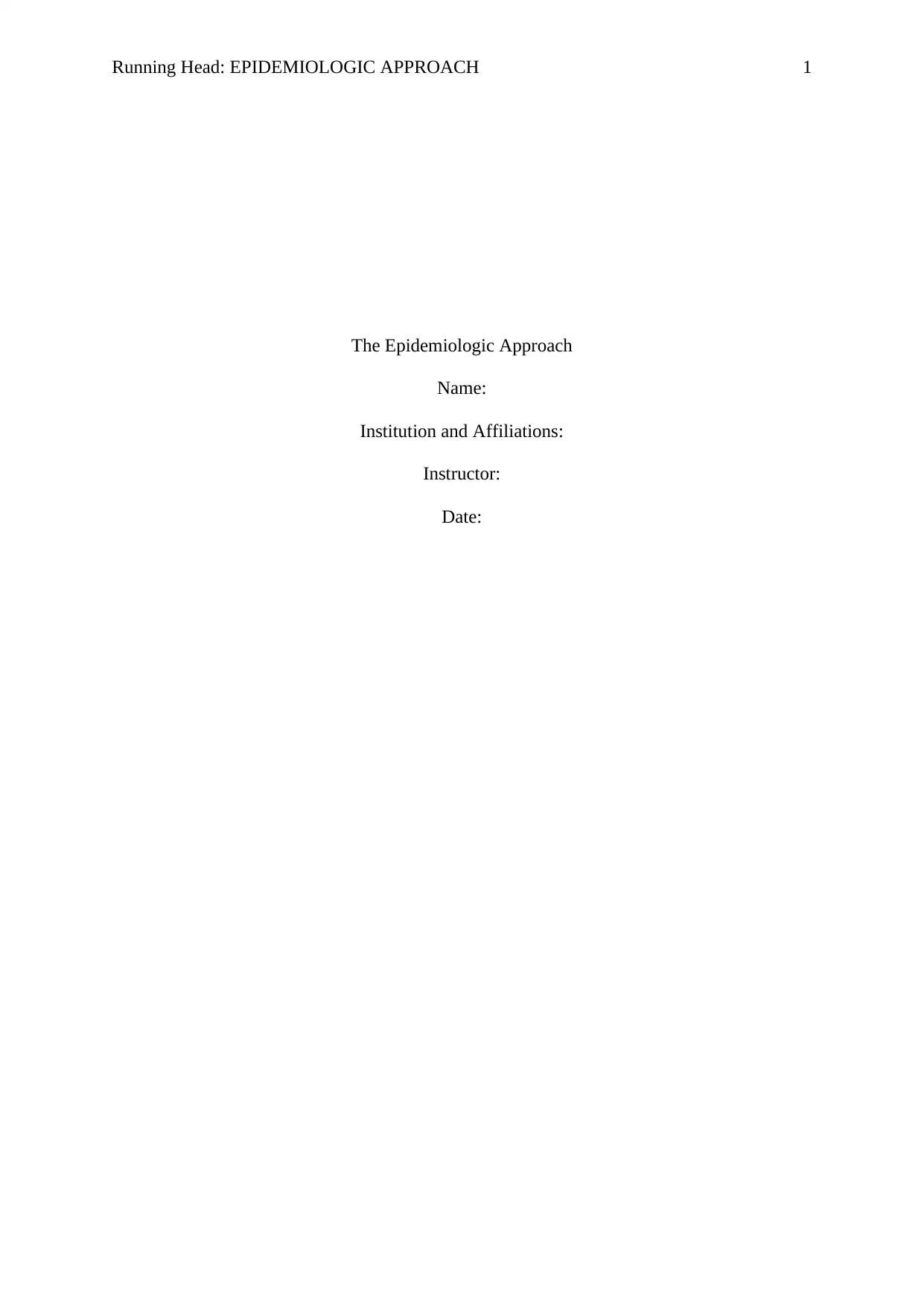
Running Head: EPIDEMIOLOGIC APPROACH 1
The Epidemiologic Approach
Name:
Institution and Affiliations:
Instructor:
Date:
The Epidemiologic Approach
Name:
Institution and Affiliations:
Instructor:
Date:
Paraphrase This Document
Need a fresh take? Get an instant paraphrase of this document with our AI Paraphraser
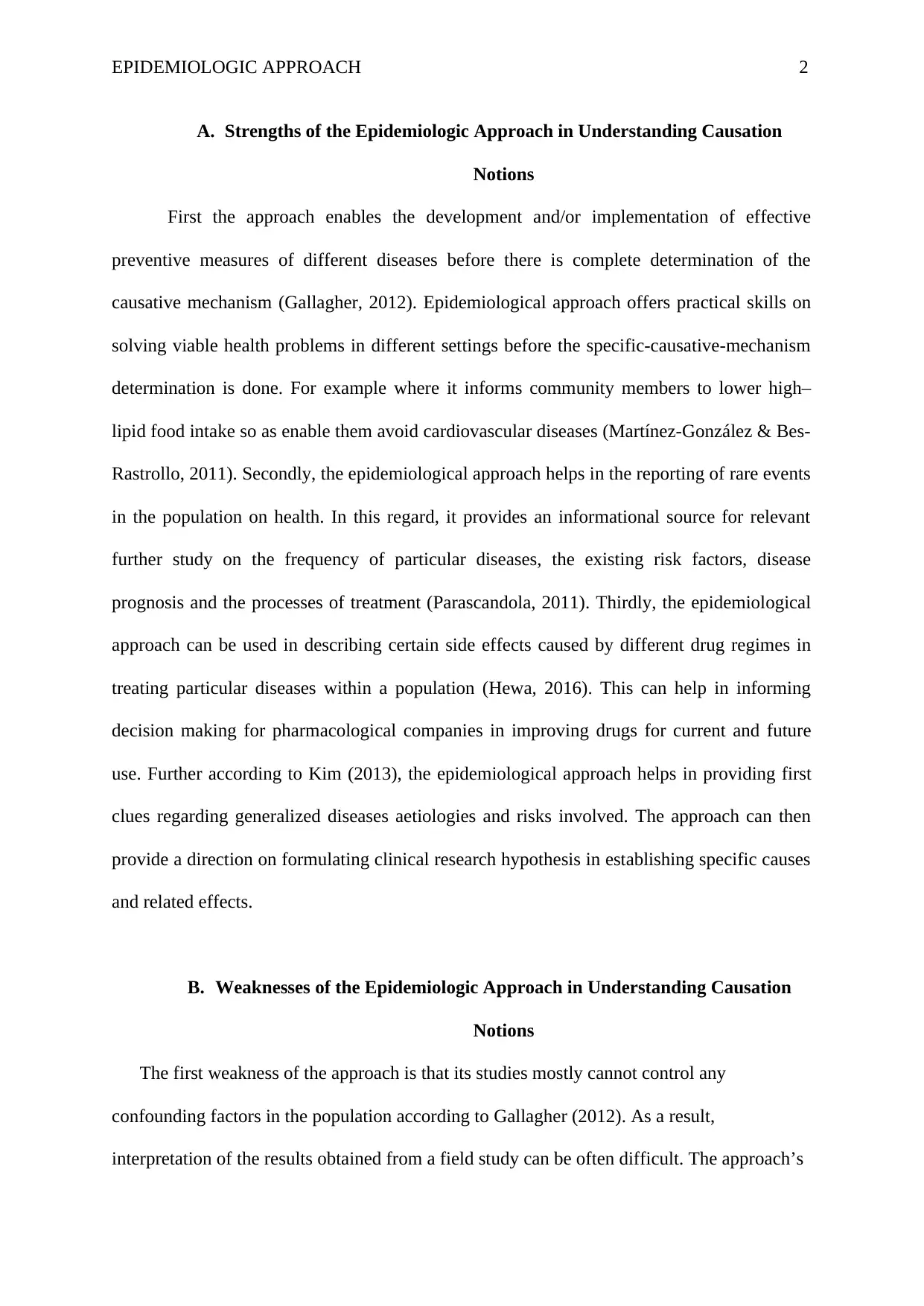
EPIDEMIOLOGIC APPROACH 2
A. Strengths of the Epidemiologic Approach in Understanding Causation
Notions
First the approach enables the development and/or implementation of effective
preventive measures of different diseases before there is complete determination of the
causative mechanism (Gallagher, 2012). Epidemiological approach offers practical skills on
solving viable health problems in different settings before the specific-causative-mechanism
determination is done. For example where it informs community members to lower high–
lipid food intake so as enable them avoid cardiovascular diseases (Martínez-González & Bes-
Rastrollo, 2011). Secondly, the epidemiological approach helps in the reporting of rare events
in the population on health. In this regard, it provides an informational source for relevant
further study on the frequency of particular diseases, the existing risk factors, disease
prognosis and the processes of treatment (Parascandola, 2011). Thirdly, the epidemiological
approach can be used in describing certain side effects caused by different drug regimes in
treating particular diseases within a population (Hewa, 2016). This can help in informing
decision making for pharmacological companies in improving drugs for current and future
use. Further according to Kim (2013), the epidemiological approach helps in providing first
clues regarding generalized diseases aetiologies and risks involved. The approach can then
provide a direction on formulating clinical research hypothesis in establishing specific causes
and related effects.
B. Weaknesses of the Epidemiologic Approach in Understanding Causation
Notions
The first weakness of the approach is that its studies mostly cannot control any
confounding factors in the population according to Gallagher (2012). As a result,
interpretation of the results obtained from a field study can be often difficult. The approach’s
A. Strengths of the Epidemiologic Approach in Understanding Causation
Notions
First the approach enables the development and/or implementation of effective
preventive measures of different diseases before there is complete determination of the
causative mechanism (Gallagher, 2012). Epidemiological approach offers practical skills on
solving viable health problems in different settings before the specific-causative-mechanism
determination is done. For example where it informs community members to lower high–
lipid food intake so as enable them avoid cardiovascular diseases (Martínez-González & Bes-
Rastrollo, 2011). Secondly, the epidemiological approach helps in the reporting of rare events
in the population on health. In this regard, it provides an informational source for relevant
further study on the frequency of particular diseases, the existing risk factors, disease
prognosis and the processes of treatment (Parascandola, 2011). Thirdly, the epidemiological
approach can be used in describing certain side effects caused by different drug regimes in
treating particular diseases within a population (Hewa, 2016). This can help in informing
decision making for pharmacological companies in improving drugs for current and future
use. Further according to Kim (2013), the epidemiological approach helps in providing first
clues regarding generalized diseases aetiologies and risks involved. The approach can then
provide a direction on formulating clinical research hypothesis in establishing specific causes
and related effects.
B. Weaknesses of the Epidemiologic Approach in Understanding Causation
Notions
The first weakness of the approach is that its studies mostly cannot control any
confounding factors in the population according to Gallagher (2012). As a result,
interpretation of the results obtained from a field study can be often difficult. The approach’s
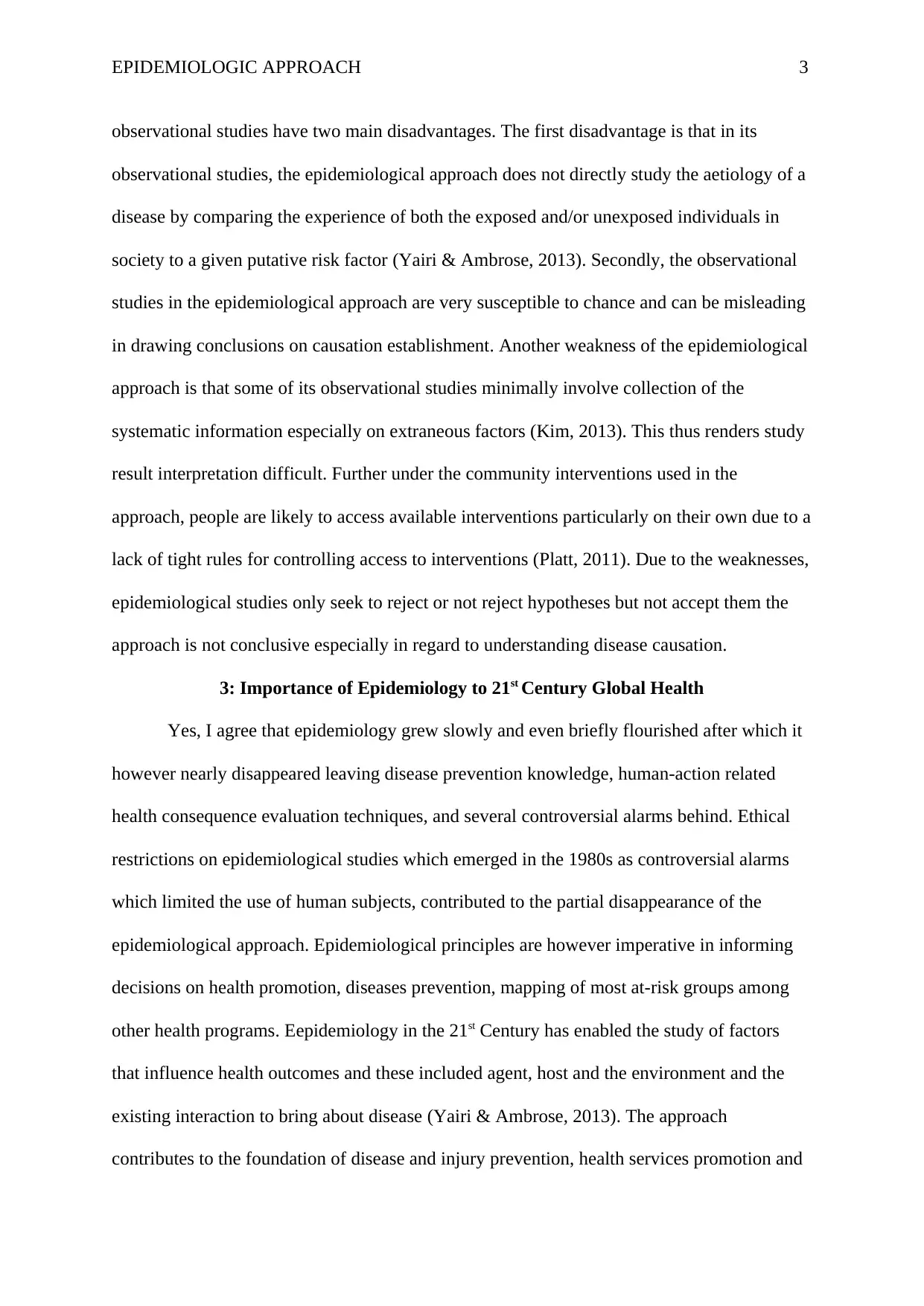
EPIDEMIOLOGIC APPROACH 3
observational studies have two main disadvantages. The first disadvantage is that in its
observational studies, the epidemiological approach does not directly study the aetiology of a
disease by comparing the experience of both the exposed and/or unexposed individuals in
society to a given putative risk factor (Yairi & Ambrose, 2013). Secondly, the observational
studies in the epidemiological approach are very susceptible to chance and can be misleading
in drawing conclusions on causation establishment. Another weakness of the epidemiological
approach is that some of its observational studies minimally involve collection of the
systematic information especially on extraneous factors (Kim, 2013). This thus renders study
result interpretation difficult. Further under the community interventions used in the
approach, people are likely to access available interventions particularly on their own due to a
lack of tight rules for controlling access to interventions (Platt, 2011). Due to the weaknesses,
epidemiological studies only seek to reject or not reject hypotheses but not accept them the
approach is not conclusive especially in regard to understanding disease causation.
3: Importance of Epidemiology to 21st Century Global Health
Yes, I agree that epidemiology grew slowly and even briefly flourished after which it
however nearly disappeared leaving disease prevention knowledge, human-action related
health consequence evaluation techniques, and several controversial alarms behind. Ethical
restrictions on epidemiological studies which emerged in the 1980s as controversial alarms
which limited the use of human subjects, contributed to the partial disappearance of the
epidemiological approach. Epidemiological principles are however imperative in informing
decisions on health promotion, diseases prevention, mapping of most at-risk groups among
other health programs. Eepidemiology in the 21st Century has enabled the study of factors
that influence health outcomes and these included agent, host and the environment and the
existing interaction to bring about disease (Yairi & Ambrose, 2013). The approach
contributes to the foundation of disease and injury prevention, health services promotion and
observational studies have two main disadvantages. The first disadvantage is that in its
observational studies, the epidemiological approach does not directly study the aetiology of a
disease by comparing the experience of both the exposed and/or unexposed individuals in
society to a given putative risk factor (Yairi & Ambrose, 2013). Secondly, the observational
studies in the epidemiological approach are very susceptible to chance and can be misleading
in drawing conclusions on causation establishment. Another weakness of the epidemiological
approach is that some of its observational studies minimally involve collection of the
systematic information especially on extraneous factors (Kim, 2013). This thus renders study
result interpretation difficult. Further under the community interventions used in the
approach, people are likely to access available interventions particularly on their own due to a
lack of tight rules for controlling access to interventions (Platt, 2011). Due to the weaknesses,
epidemiological studies only seek to reject or not reject hypotheses but not accept them the
approach is not conclusive especially in regard to understanding disease causation.
3: Importance of Epidemiology to 21st Century Global Health
Yes, I agree that epidemiology grew slowly and even briefly flourished after which it
however nearly disappeared leaving disease prevention knowledge, human-action related
health consequence evaluation techniques, and several controversial alarms behind. Ethical
restrictions on epidemiological studies which emerged in the 1980s as controversial alarms
which limited the use of human subjects, contributed to the partial disappearance of the
epidemiological approach. Epidemiological principles are however imperative in informing
decisions on health promotion, diseases prevention, mapping of most at-risk groups among
other health programs. Eepidemiology in the 21st Century has enabled the study of factors
that influence health outcomes and these included agent, host and the environment and the
existing interaction to bring about disease (Yairi & Ambrose, 2013). The approach
contributes to the foundation of disease and injury prevention, health services promotion and
⊘ This is a preview!⊘
Do you want full access?
Subscribe today to unlock all pages.

Trusted by 1+ million students worldwide
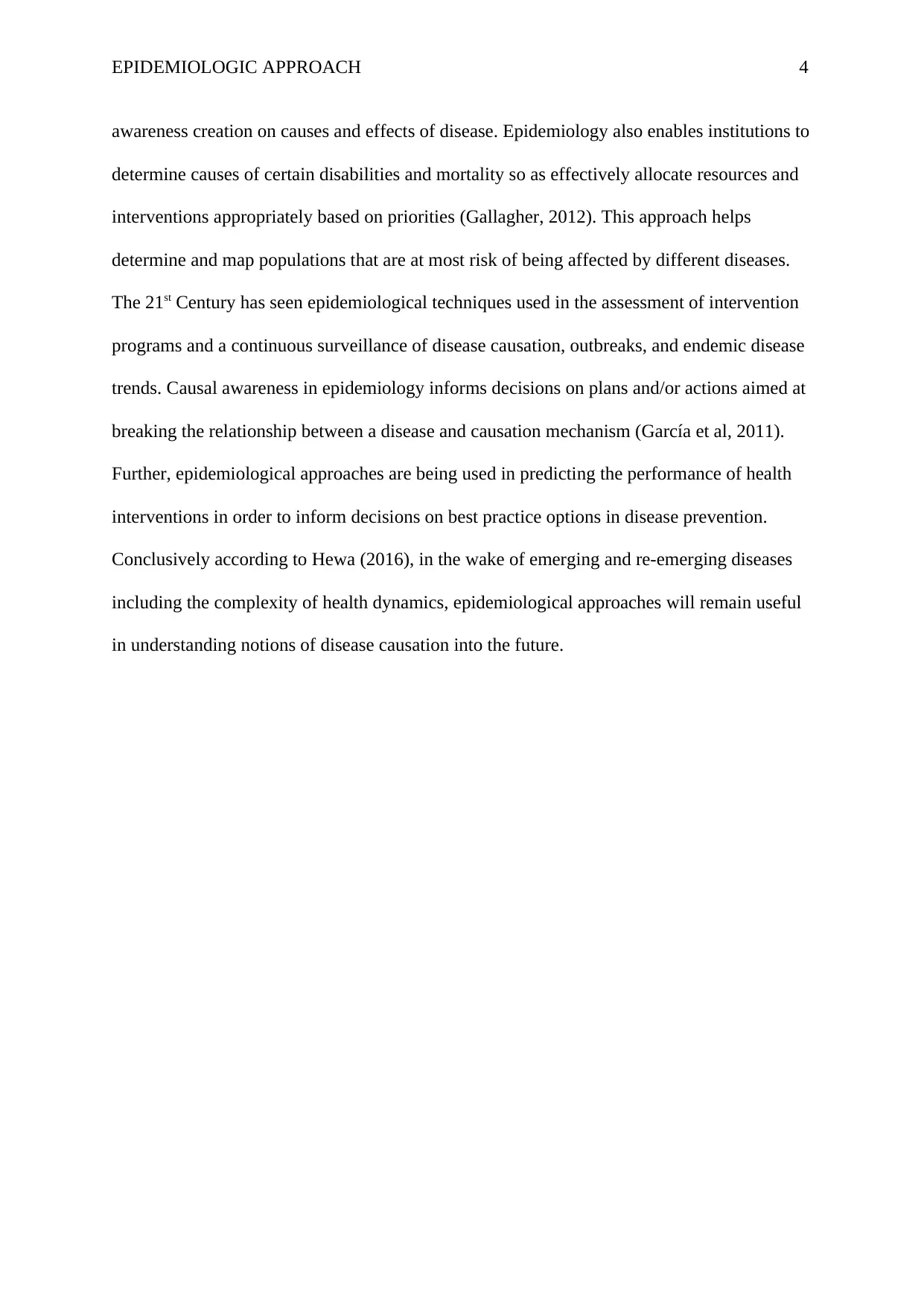
EPIDEMIOLOGIC APPROACH 4
awareness creation on causes and effects of disease. Epidemiology also enables institutions to
determine causes of certain disabilities and mortality so as effectively allocate resources and
interventions appropriately based on priorities (Gallagher, 2012). This approach helps
determine and map populations that are at most risk of being affected by different diseases.
The 21st Century has seen epidemiological techniques used in the assessment of intervention
programs and a continuous surveillance of disease causation, outbreaks, and endemic disease
trends. Causal awareness in epidemiology informs decisions on plans and/or actions aimed at
breaking the relationship between a disease and causation mechanism (García et al, 2011).
Further, epidemiological approaches are being used in predicting the performance of health
interventions in order to inform decisions on best practice options in disease prevention.
Conclusively according to Hewa (2016), in the wake of emerging and re-emerging diseases
including the complexity of health dynamics, epidemiological approaches will remain useful
in understanding notions of disease causation into the future.
awareness creation on causes and effects of disease. Epidemiology also enables institutions to
determine causes of certain disabilities and mortality so as effectively allocate resources and
interventions appropriately based on priorities (Gallagher, 2012). This approach helps
determine and map populations that are at most risk of being affected by different diseases.
The 21st Century has seen epidemiological techniques used in the assessment of intervention
programs and a continuous surveillance of disease causation, outbreaks, and endemic disease
trends. Causal awareness in epidemiology informs decisions on plans and/or actions aimed at
breaking the relationship between a disease and causation mechanism (García et al, 2011).
Further, epidemiological approaches are being used in predicting the performance of health
interventions in order to inform decisions on best practice options in disease prevention.
Conclusively according to Hewa (2016), in the wake of emerging and re-emerging diseases
including the complexity of health dynamics, epidemiological approaches will remain useful
in understanding notions of disease causation into the future.
Paraphrase This Document
Need a fresh take? Get an instant paraphrase of this document with our AI Paraphraser
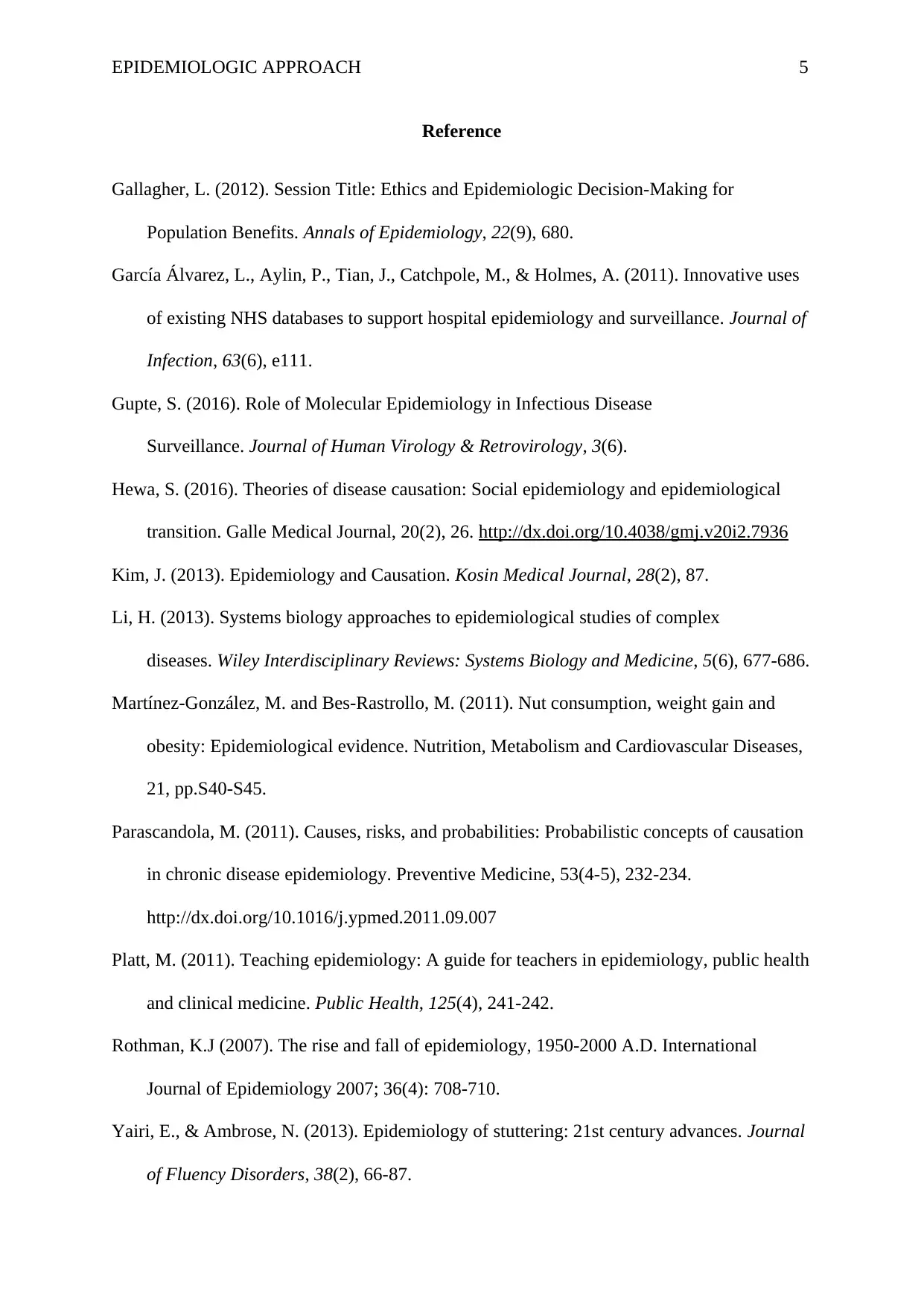
EPIDEMIOLOGIC APPROACH 5
Reference
Gallagher, L. (2012). Session Title: Ethics and Epidemiologic Decision-Making for
Population Benefits. Annals of Epidemiology, 22(9), 680.
García Álvarez, L., Aylin, P., Tian, J., Catchpole, M., & Holmes, A. (2011). Innovative uses
of existing NHS databases to support hospital epidemiology and surveillance. Journal of
Infection, 63(6), e111.
Gupte, S. (2016). Role of Molecular Epidemiology in Infectious Disease
Surveillance. Journal of Human Virology & Retrovirology, 3(6).
Hewa, S. (2016). Theories of disease causation: Social epidemiology and epidemiological
transition. Galle Medical Journal, 20(2), 26. http://dx.doi.org/10.4038/gmj.v20i2.7936
Kim, J. (2013). Epidemiology and Causation. Kosin Medical Journal, 28(2), 87.
Li, H. (2013). Systems biology approaches to epidemiological studies of complex
diseases. Wiley Interdisciplinary Reviews: Systems Biology and Medicine, 5(6), 677-686.
Martínez-González, M. and Bes-Rastrollo, M. (2011). Nut consumption, weight gain and
obesity: Epidemiological evidence. Nutrition, Metabolism and Cardiovascular Diseases,
21, pp.S40-S45.
Parascandola, M. (2011). Causes, risks, and probabilities: Probabilistic concepts of causation
in chronic disease epidemiology. Preventive Medicine, 53(4-5), 232-234.
http://dx.doi.org/10.1016/j.ypmed.2011.09.007
Platt, M. (2011). Teaching epidemiology: A guide for teachers in epidemiology, public health
and clinical medicine. Public Health, 125(4), 241-242.
Rothman, K.J (2007). The rise and fall of epidemiology, 1950-2000 A.D. International
Journal of Epidemiology 2007; 36(4): 708-710.
Yairi, E., & Ambrose, N. (2013). Epidemiology of stuttering: 21st century advances. Journal
of Fluency Disorders, 38(2), 66-87.
Reference
Gallagher, L. (2012). Session Title: Ethics and Epidemiologic Decision-Making for
Population Benefits. Annals of Epidemiology, 22(9), 680.
García Álvarez, L., Aylin, P., Tian, J., Catchpole, M., & Holmes, A. (2011). Innovative uses
of existing NHS databases to support hospital epidemiology and surveillance. Journal of
Infection, 63(6), e111.
Gupte, S. (2016). Role of Molecular Epidemiology in Infectious Disease
Surveillance. Journal of Human Virology & Retrovirology, 3(6).
Hewa, S. (2016). Theories of disease causation: Social epidemiology and epidemiological
transition. Galle Medical Journal, 20(2), 26. http://dx.doi.org/10.4038/gmj.v20i2.7936
Kim, J. (2013). Epidemiology and Causation. Kosin Medical Journal, 28(2), 87.
Li, H. (2013). Systems biology approaches to epidemiological studies of complex
diseases. Wiley Interdisciplinary Reviews: Systems Biology and Medicine, 5(6), 677-686.
Martínez-González, M. and Bes-Rastrollo, M. (2011). Nut consumption, weight gain and
obesity: Epidemiological evidence. Nutrition, Metabolism and Cardiovascular Diseases,
21, pp.S40-S45.
Parascandola, M. (2011). Causes, risks, and probabilities: Probabilistic concepts of causation
in chronic disease epidemiology. Preventive Medicine, 53(4-5), 232-234.
http://dx.doi.org/10.1016/j.ypmed.2011.09.007
Platt, M. (2011). Teaching epidemiology: A guide for teachers in epidemiology, public health
and clinical medicine. Public Health, 125(4), 241-242.
Rothman, K.J (2007). The rise and fall of epidemiology, 1950-2000 A.D. International
Journal of Epidemiology 2007; 36(4): 708-710.
Yairi, E., & Ambrose, N. (2013). Epidemiology of stuttering: 21st century advances. Journal
of Fluency Disorders, 38(2), 66-87.
1 out of 5
Your All-in-One AI-Powered Toolkit for Academic Success.
+13062052269
info@desklib.com
Available 24*7 on WhatsApp / Email
![[object Object]](/_next/static/media/star-bottom.7253800d.svg)
Unlock your academic potential
Copyright © 2020–2025 A2Z Services. All Rights Reserved. Developed and managed by ZUCOL.


